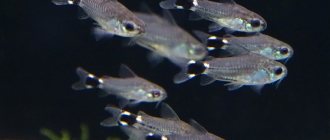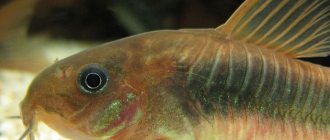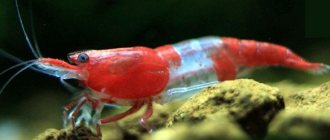03/28/2019Pisces0
Corydoras panda is a species of ray-finned fish, a representative of the genus Corydoras, of the family Armored catfish (Callichthidae). It got its name for its unique color and peaceful character.
- 1 Description and habitat
- 2 Mr. Tail Recommends: Basics of Aquarium Keeping
- 3 Compatibility
- 4 Feeding
- 5 Breeding
- 6 Diseases and prevention 6.1 Bacterial
- 6.2 Viral
- 6.3 Parasitic
Description
The Panda catfish belongs to the ray-finned fish from the armored catfish family. But it was not only the color that gave rise to this name, but also the peaceful nature of the Corydoras.
A photo of Panda will help you appreciate the interesting appearance of the catfish. The oblong body is slightly compressed at the sides, the back is high. The color of the corydoras has a wide palette: from white to light pink.
To protect itself from opponents, the aquarium catfish uses bone plates, which are located on the sides of the body in 2 rows. Breathing in underwater inhabitants is intestinal and gill. From time to time the Panda comes to the surface to take a breath of air.
Characteristic
Corydoras got its unusual name due to its resemblance to a panda; the fish is also known as the veiled catfish. These pets are distinguished by a light, pale pink color; three dark spots are noticeable on their sides, and they are located in strictly defined places, namely:
- around eyes;
- near the tails;
- on the back.
There are rather large eyes on the head, and a large mouth a little lower. The entire body is covered with small scales, with bone plates visible on the sides. Like all catfish, corydoras have three pairs of antennae around their mouths - they help the fish navigate in the water and get food. To protect the animal, there are sharp spines near the eyes and on the dorsal fin, with which these little pandas fight off all aquatic predators. The body length of an adult fish reaches 5.5 cm; if a comfortable habitat is created in the aquarium, Corydoras can live up to 15 years.
Content
Keeping the Corydoras Panda fish in an artificial reservoir must comply with the requirements that the pet places on the volume of the tank, water, lighting, and quality of food.
Rule 1. Suitable water
In their natural environment, Pandas inhabit bodies of water with slow currents. They love soft, clean water with a low acidity level. There must be a lot of oxygen in the water.
Corydoras easily tolerate a decrease in water temperature to +16°C, even at +12°C nothing will happen to them. They are calm about the increase, but the optimal temperature regime is +23-26°C.
Fish need clean water. It is recommended to perform a water change of 1/3 of the total volume of the tank weekly. It is necessary to install an aerator in the aquarium and a filter. Soft water with a slightly acidic-neutral environment are ideal parameters for keeping Corydoras Panda.
Unlike natural species, captive-bred Panda catfish prefer warm water, while their wild relatives can easily tolerate cold water. Domestic catfish cannot tolerate frequent and sudden changes in temperature, so the water parameters in the aquarium should be maintained at the same level.
Rule 2. Soil + driftwood for shelter
Fine-grained sand is good as a soil. In addition to plants, it is advisable to decorate the bottom of the aquarium with coconut shells, install a grotto, cave, put driftwood - create shelters. With decorative elements that will serve as a place for the catfish to escape from other aquatic inhabitants, the Panda will feel comfortable.
Feeding
Panda catfish is an omnivorous fish, unpretentious in terms of food choice, and therefore it is quite easy to care for it.
Suitable live food is: cyclops, shrimp, worms, tubifex, brine shrimp, mosquito larvae, daphnia, etc. Regarding dry food, we cannot fail to mention special tablets and granules for bottom fish.
Corydoras Panda should be fed in the evening, when their activity increases significantly. Since the catfish is a demersal fish species, it is necessary to ensure that competing individuals from the upper strata of the water space do not interfere with this process by eating the food before it reaches the bottom.
Compatibility
In their homeland, catfish prefer a gregarious lifestyle and cannot stand loneliness. Therefore, it is recommended to create similar conditions in an artificial tank and buy a couple of individuals.
Being alone with himself, Panda begins to get sick and dies. The 10 liter tank is ideal for storing 4 corridors. The fish easily get along with small species of underwater inhabitants and bottom dwellers. It is recommended to select one or more fish from the list as neighbors:
- tetras;
- iris;
- rasboras;
- barbs;
- swordtails;
- angelfish.
Be careful!
Aggressive, large and active aquarium fish are not neighbors for corydoras, so they cannot be kept in the same container. For example, cichlids and astronotuses in an aquarium will constantly conflict with Pandas.
Habitat of Corydoras
The natural habitat of Corydoras in nature is the rivers of Central and South America (in the Amazon, Paraguay, and Orinoco river basins).
They prefer silty, standing or slow-moving water. Catfish constantly swarm in the soil of rivers in search of food, and dense vegetation serves as protection from predators.
This region is characterized by the drying up of rivers at the end of the rainy seasons. To survive, these fish have learned to swallow air from the surface of the water, although they do not have a special organ for breathing, like labyrinth fish. Thus, corydoras absorb oxygen through the intestines. Such living conditions make them hardy and unpretentious, which has become another plus for aquarists.
(2 ratings, average 4.5 out of 5)
Reproduction and breeding
Corydoras catfish of this species reproduce well in captivity, but certain conditions must be created for them.
You can't do without a spawning aquarium. The choice of tank volume is influenced by the number of individuals. Which will spawn. In any case, the aquarium should not be less than 30 liters. For one female you need to buy 2 males.
In the spawning tank, it is advisable to maintain the temperature at +23°C and not allow it to rise. Lower temperatures are acceptable. A filter with a sponge must be installed in the tank. The bottom of the aquarium should be decorated with artificial plants or Java moss.
To stimulate reproduction, it is necessary to give your pets live food and change the water in the container by 70% every day. The temperature of the new water that will be added to the tank should be 2° lower than it is currently in the spawning tank. Such procedures must be carried out until the Pandas begin to spawn.
Diet features
The fish are completely unpretentious in nutrition: they eat live, frozen and dry food with appetite.
Since fish live on the bottom, you need to choose sinking food, for example, special for catfish.
Favorite delicacies : daphnia, tubifex, bloodworms and brine shrimp.
It is preferable to feed in the evening , since Corydoras are more active at night and spend their days hiding in shelters.
Diseases and prevention
If Corydoras catfish are not kept correctly (unbalanced food, inappropriate temperature), the fish begin to suffer from bacterial, viral and parasitic diseases. If an infected individual is not treated, it will die.
Bacterial
Fish tuberculosis or mycobacteriosis develops as a result of damage to the fish body by microbacteria. The disease is transmitted by contact from infected fish or through contact with a poorly treated aquarium.
Symptoms:
- refusal of food;
- bulging eyes;
- finding a place to retire;
- ruffled scales;
- a neoplasm appears on the abdomen;
- the fish swims on its side.
Tuberculosis is incurable.
Attention!
If other individuals have been in contact with the sick fish, it is necessary to arrange a quarantine. The aquarium must be thoroughly disinfected using special products.
Panda catfish are susceptible to a considerable number of different diseases.
Fin rot is caused by bacteria. The main cause of the disease is poor care and too low a temperature.
Symptoms:
- fins are edged with white;
- cloudy eyes;
- damage followed by decomposition of the fins with the capture of part of the body.
The fish may die. To save the lives of aquatic inhabitants, it is necessary to replace more than half of the water in the tank and increase the temperature of the liquid by several degrees. Streptocide is dissolved in water at the rate of 1.5 g of medicinal powder per 10 liters.
Viral
Cluster nodule or lymphocytosis is a dangerous disease that can be fatal.
Symptoms:
- scars and ulcers on the body;
- substandard seals can be felt on the lymph nodes;
- Dark colored formations are visible throughout the body.
Important!
The late stage of the disease is similar to the disease ichthyophthyriasis, but unlike it, lymphocytosis does not change the behavior of aquarium fish.
If bulges appear on the fins, they can be cauterized. But this cannot be done on the body, so such individuals will have to be removed. An infected aquarium must be disinfected: the plants must be removed and burned, and the soil must be calcined over a fire. Rinse the container itself with special products. All contacted individuals are transferred to quarantine. They are monitored daily.
Parasitic
Ichthyophthyrius and ectoparasitic ciliated ciliates contribute to the development of ichthyophthyriosis.
Symptoms:
- small white spots are randomly scattered throughout the body;
- fish rub their bodies against objects in the tank;
- mobility decreases;
- loss of appetite;
- catfish stop responding to stimuli;
- frequent ascents to the surface for a breath of oxygen.
If the disease is started, a massive fish death will begin. To get rid of parasites, you need to change the water by 1/3 of the volume and increase the temperature by a few degrees. Such measures will not be enough, so malachite green is added to the water.
If salt baths are used to treat other fish, then this method of treatment is completely unsuitable for Panda Corydoras. Do not use medications containing copper. Such therapy will lead to death.
The causes of diseases in Corydoras Panda are often associated with improper care
Choosing the right healthy catfish in the store
Catfish have strong immunity. They are able to withstand temperature changes.
When purchasing fish, pay attention to the behavior of the selected representative of the fish world:
- You should not take fish lying on the bottom and not paying attention to external stimuli;
- Look how representatives of the water element breathe. Fish breathing should not be heavy, but the absorption of air should be lightning fast, after which the fish actively begins to decline. If a fish suffers from an illness, then it is constrained in its movements, and seems to fly to the bottom like a stone.
- Watch the fish swim. If at the same time it itches, the movement is jerky, there are problems with coordination balance and spatial orientation, then leave such a fish in the store;
- Attractive spots and large growths indicate a destructive fungus. Reddish spots on the abdomen indicate a hidden bacterial infection.
- Be sure to check the integrity of the mustache; it is better to discard damaged ones.
- The fins are intact, straightened, without traces of destructive fin rot. If they are stuck together or have pronounced red stripes, take a closer look at another shell;
- The eyes of a healthy fish are clean, not covered with film or cloudiness, not bulging or sunken.
- Avoid catfish with visually inflamed or mucus-covered respiratory gills. It is dangerous if they are too dark - this is a sign of nitrogen intoxication.
- You should not buy shellfish with a thin, sunken or convex abdomen. The first indicates the presence of pathogenic microorganisms or complete depletion. And the second may be a signal of many hidden illnesses that end in death.
- And lastly, buy fish of different sizes, and not just the most massive ones.
It is better to take active fish
When choosing a suitable specimen, pay attention to the following signs of sickness in catfish:
- Sticky fins;
- Cloudiness of the eyes, film coating;
- Damaged mustache;
- Inflammation or redness on the gills.
Red-brown spots are a sign of the development of a pathogenic fungus in the fish’s body. A sunken abdomen indicates exhaustion and helminth infestation.
Corydoras catfish are schooling, unpretentious, cheerful fish. If you follow the general rules of care, they will live and delight you with their beautiful appearance for 15 years. Follow the prescribed valuable recommendations, carefully select shellfish before purchasing, quarantine newcomers, all these actions will help you avoid major mistakes in keeping peace-loving catfish.
Adviсe
Important recommendations will help prevent possible mistakes that can be made when caring for Panda Corydoras.
- Catfish do not like dirty water. During weekly water changes, it is recommended to clean the soil as well.
- To strengthen the immunity of the fish, dry beech or oak leaves should be placed on the bottom of the aquarium.
- Corydoras love dark soil, but do not like light soil.
- The bottom of the spawning tank should be decorated with Java moss.
- Catfish are peaceful fish; they get along with all the inhabitants of the aquarium, even shrimp.
- In babies, until they are 3 months old, the coloring is significantly different from adults. This point is important to consider when purchasing.
You cannot keep a Panda in a small aquarium, as the fish will not be comfortable in it. It is recommended to adhere to the established parameters.
General information
Panda catfish is a school creature. Usually the fish do not leave the group ( it is better if there are at least 6 individuals in the school ). The fish have been known since 1968 (then they were acquired by collector Randolph Richards), but they received their name only 3 years later.
It is almost impossible to find wild specimens for sale. The commercially available catfish are bred on farms in Eastern Europe and the Far East.
Interesting! The veiled panda was bred just a few years ago by German breeders. This variety is distinguished by its elongated tail fin and golden sand color.
Reviews
Panda catfish are unpretentious fish that are suitable even for beginners. Their unusual coloring has made them popular pets.
Would you like to purchase a Catfish Corydoras for your own aquarium? Share in the comments!
Panda catfish - causes of death
Aquarium inhabitants require good care. If the panda corydoras catfish is bred incorrectly and without paying attention to temperature and nutrition, then the beautiful creatures will quickly get sick. We list the main reasons for the death of these fish:
- Poor water quality.
- Overpopulation of the aquarium.
- A drop in temperature above or below normal.
- Use of spoiled feed.
- Presence of harmful organisms.
- Water changes are carried out rarely or with irregularities.
- If the fish gets into a new aquarium with a different water composition, it may not survive acclimatization.











